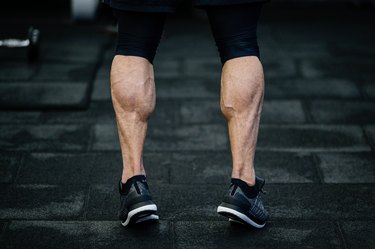
Calf raises are a popular lower-body strength-training exercise. You can do them as a body-weight exercise or as a weighted exercise with dumbbells, a barbell or ankle weights to provide additional resistance for muscle strengthening purposes.
How to Do Calf Raises Properly
- Stand near a wall with your hands on the wall for support and balance.
- Rise up on the balls of your feet as high as you can go.
- Lower back down to the ground, not allowing your heels to touch the ground in between reps.
- Perform 3 sets of 10 to 12 repetitions.
Video of the Day
3 Benefits of Doing Calf Raises
1. Builds Muscular Strength
One of the benefits of calf raises is improved muscular strength. The muscles in your calves are your gastrocnemius and soleus muscles. Your gastrocnemius, the larger of the two muscles, runs from the bottom of your thigh bone down to your Achilles tendon.
Your soleus, located underneath your gastrocnemius, starts at the top of your tibia in your lower leg and also attaches to your Achilles tendon. Calf raises will not only strengthen these two muscles, they will also give definition to your lower leg, improving its appearance.
2. Helps Rehabilitate Achilles Tendon
Calf raises are often used as a rehabilitative exercise for Achilles tendon injuries. Whether you have a Achilles tear or Achilles tendonitis, by strengthening your gastrocnemius and soleus muscles, you can reduce the amount of stress on your Achilles tendon and help it heal.
An important companion to calf raises when rehabilitating an Achilles injury is calf stretching. After performing your calf raises at the wall, simply extend one leg straight behind you with your heel pressed into the ground. Keep both toes facing the wall as you lean forward stretching out the muscles you just worked with calf raises.
Warning
If you have an Achilles tendon injury, make sure you get the all-clear from your doctor or physical therapist before doing any specific stretching or strengthening exercises.
3. Supports Higher Jumps
Athletes who participate in basketball, track, cheerleading and gymnastics are always looking for ways to jump higher. Calf raises are one answer to this quest. By building stronger gastrocnemius and soleus muscles with calf raises you can increase your vertical jump.
Be careful not to over train your calf muscles with calf raises. Take one day off between each training session so your calves can recover and rebuild, growing stronger.
Was this article helpful?
150 Characters Max
0/150
Thank you for sharing!
Thank you for your feedback!